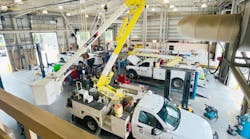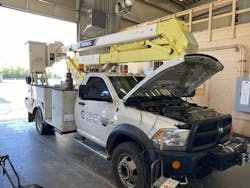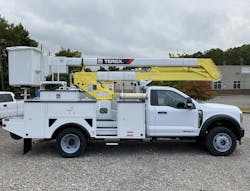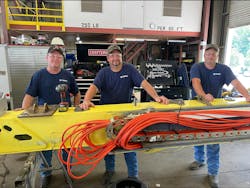Good Maintenance Sets Utility Bucket Trucks up for Second Life
With a reputation for having one of the nicest fleets in the Southeast, Coast Electric says the secret is a strong maintenance plan and rebuild strategy. Rebuilding its bucket trucks helps to maximize its fleet budget and gives the co-op flexibility to customize the upfit and take advantage of shorter turnaround times compared to waiting for a newly built bucket truck.
Coast Electric has a fleet of about 225 trucks. Half of those are aerial devices, the bulk of which are Hi-Ranger HR40 over center aerials from Terex. They also own several larger bucket trucks and digger derricks.
“The HR40 is bullet proof. It’s a solid unit that we can easily get 25 years out of when it’s all said and done,” said Jesse Hardee, fleet supervisor. “It’s the chassis that wears out first, especially driving in rural areas with rougher roads, so planning to rebuild the aerial device just makes sense,” he said.
There are three factors the fleet supervisor considers when deciding to rebuild an HR40. If at least one of these factors are met, then he plans for the unit to be rebuilt.
- Is the aerial device 10 years old?
- Does the chassis have more than 350,000 miles on it?
- Is the truck chassis a lemon, experiencing an unusual number of needed repairs before
reaching 350,000 miles?
The factors that trigger when it is time for a rebuild may vary based on geography, however, it is common in rural parts of the country for the truck to get beat up driving up to eight hours per day, while the boom and bucket are only used for three to four hours of that day.
While a rebuilt bucket truck is easily half the price of a new one, it’s also the lead time that appeals to the fleet supervisor. Back orders on the chassis are often the biggest delay. But once a truck is found in stock at a dealership, the rebuild process at Terex Equipment Services takes as few as six to eight weeks. By comparison, the process to spec and buy a brand-new bucket truck can take as long as two years. With the rebuild, the co-op also gets to keep their old truck until the new chassis arrives. “That shortens the amount of time we are down a truck,” said Hardee.
The Right Way to Rebuild
A rebuild is not the same as a unit transfer. Hardee explains that moving a used aerial device to a new chassis without spending the money for a proper rebuild won’t get you the same performance. “Just giving the aerial device a paint job and new stickers and putting it on a new chassis defeats the purpose. It’s not worth it,” he says. “When done correctly, expect the unit to look and operate like it’s brand new,” he said. In fact, of all the rebuilt HR40s Hardee has put back into his fleet over the last five years, he has never had a warranty claim — or even a hose blow — on a rebuilt bucket truck from Terex. The extended operational life gained from the rebuild ultimately saves the co-op time and money.
Terex Equipment Services starts with doing an inspection. “When I know I have a unit that has reached the time for rebuild, I call Eric and he comes to our site to look at the truck. He goes back and starts building an estimate,” said Hardee.
Before beginning the project, Coast Electric seeks input from their line crews. This is a chance to change the fit to make their work more efficient. Things like moving the toolbox on top of bins, adding storage for guy wire reels, or adding new lighting packages give them a chance to customize the truck to the preferences of the crew.
Meanwhile, the Terex Equipment Services team starts a search for a new chassis. “We used to buy our own chassis, but letting Terex locate it and order it is so much easier. They know better than me how the chassis needs to be laid out for the wiring harnesses and suspension,” said Hardee. “I don’t want to mess that up when buying the truck, so I just let them take care of it.”
“Another perk is that this relieves the customer from having to finance the truck separately from the rebuild. We can invoice the entire thing at once, and the customer doesn’t have the chassis just sitting idle until it’s time for the rebuild,” adds Tony Cole, Branch Manager at the Birmingham, Alabama, Terex Service Center.
All rebuilds of the aerial device include replacing the rotation bearing and basket leveling components, resealing all the cylinders and replacing all the hoses. “Those are the main components that are quoted every time. Then as we are working on the aerial device, we may find other things, such as seized pins, electrical issues and minor body damage. We go back to the customer with estimates for those additional items as we find them,” said Cole.
The Birmingham team includes five people that solely focus on rebuilds. “They are just outstanding,” said Hardee. “I’ve even had problems on new trucks and called them for help — one of the guys is an electrical genius!”
At the Birmingham location, the rebuild team has 110 years of experience between them and they are trained on a variety of brands of aerial devices and digger derricks. “This team takes a lot of pride in their craftmanship. Many of them have been rebuilding equipment for 20 years,” adds Cole.
Spend Money to Save Later
The key to Coast Electric’s success is that they don’t cut corners on maintenance. Two shops house nine full-time technicians who are responsible for the fleet’s repairs. “We repair all of our own hydraulic leaks, replace buckets, repair fiberglass and do all of our own inspections except the five-year, which is outsourced to Terex,” said Kellin Cuevas, Shop Technician for Coast Electric.
They also have the philosophy that maintenance — no matter how small — should not be deferred. “If you find something, go ahead and fix it, because in the long run you keep other problems from happening. That’s the difference in perspective if you want your equipment to last a long time,” said Hardee.
However, they are also smart about it. Coast Electric invested in an oil analysis system for the chassis engine oil. They started out testing the oil at 3,000-mile intervals, then at 4,000, 6,000 and 8,000 intervals. Based on this they determined that they didn’t need to change the chassis engine oil until 8,000 miles.
The oil analysis also helps them catch problems before they become expensive. “In one case, the analysis showed us that we needed a new fuel pump, which saved us from having to put in a $50,000 motor that got ruined,” said Hardee.
“We see other equipment being considered for rebuild that is not taken care of as well as Coast Electric’s fleet. It just makes financial sense to spend a little money up front on maintenance, which cuts down on the work involved in the rebuild,” said Cole. Units that have not been as well maintained over their life are going to be more expensive to rebuild.
Cuevas suggests keeping up on inspections of hoses, air lines and handles. “Keeping up on the little things keeps big problems from happening,” he said. “The annual inspection is very important. We take the time to check everything — rotation bearing torque specs, pressures, every nut and bolt. It takes a while, but we catch everything,” said Cuevas.
Ultimately, the three factors Hardee uses when deciding to do a rebuild were established based on input from the experienced technicians at Coast Electric. Those triggers account for getting as much life as possible out of the chassis, but before the aerial unit is too worn out to warrant rebuilding it.
“If you have a good solid maintenance program, then rebuilds are the way to go. I’d tell any fleet manager out there, this is the best business decision you’ll make when it comes to managing your budget,” said Hardee. On average, he sends three to four units per year for rebuild. The money he saves is re-allocated for investment in other equipment. “We buy something new every year, so that we can stagger the units that are eligible for rebuild,” said Hardee.





